Insights
Seasonal Packaging: Your Complete Guide to Success
Seasonal packaging sells. It's one of the most effective ways for food brands to boost revenue, attract new customers, and reinforce brand identity - no matter the occasion.
Whether it’s Christmas, Easter, Halloween, or Valentine’s Day, the right seasonal packaging creates emotional connections with consumers and drives significant sales increases during busy shopping periods. Getting seasonal packaging right requires careful planning, thoughtful design, and an understanding of what resonates with consumers during different times of the year. The packaging itself becomes part of the product experience.
With over 45 years of experience at the forefront of seasonal packaging innovation, we know exactly what it takes to deliver campaigns that stand out on the shelf and drive sales. This guide covers everything you need to know – from planning and design principles to occasion-specific insights that help your seasonal packaging succeed.
We highly recommend reading the full guide, but you can navigate to specific sections if you are short on time.
- Our Tips For Seasonal Packaging
- What to Avoid When Creating Seasonal Packaging
- Examples of Seasonal Packaging
- How We Can Help You Create Award-Winning Seasonal Packaging
Our Tips For Seasonal Packaging
Successful seasonal packaging shares several key characteristics that make it effective in driving sales and creating memorable brand experiences. Whilst some principles can be applied to a greater extent depending on the occasion, they all play a part in delivering a strong seasonal campaign.
- Start with clear objectives – Define what you want to achieve. Understanding your target retail environment, desired shelf presence, and brand positioning shapes every design decision.
- Balance festive and brand identity – Your seasonal packaging should feel celebratory whilst remaining unmistakably yours. The best designs incorporate seasonal elements without losing brand recognition. Don’t rip out the heart of your brand identity for a seasonal event.
- Brand loyalty through collectability – Limited-edition packaging works when consumers want to keep it. Premium materials like tin naturally encourage retention and reuse, increasing brand loyalty that extends well beyond the season.
- Consider the full customer journey – Think about how your packaging looks on the shelf, presented as a gift, and displayed at home. Each touchpoint matters, and your packaging needs to look great in every scenario.
- Design to be different – Standing out during peak seasons means going beyond generic festive imagery. Look for unique angles that connect your brand story to the occasion. Consider integrating emerging packaging design trends into your project.
- Design for shareability – Seasonal packaging increasingly lives on social media, with consumers sharing unboxing experiences and gift reveals. Consider how your packaging photographs and films – bold colours, interesting textures, and premium finishes all perform well in user-generated content.
- Utilise gift packs – Multi-product gifts encourage customers to purchase your full range rather than individual items. Curated gift sets command higher price points and increase average order value whilst offering a ready-made gifting option for your consumers.
- Test and test again – Prototype designs and gather feedback from target consumers. It is essential to understand how your product will be received by the market, and we can’t stress enough the importance of testing before committing to full production runs.
Apply these principles consistently, and your seasonal packaging will have the best possible foundation for success. That said, avoiding common pitfalls is arguably even more important.
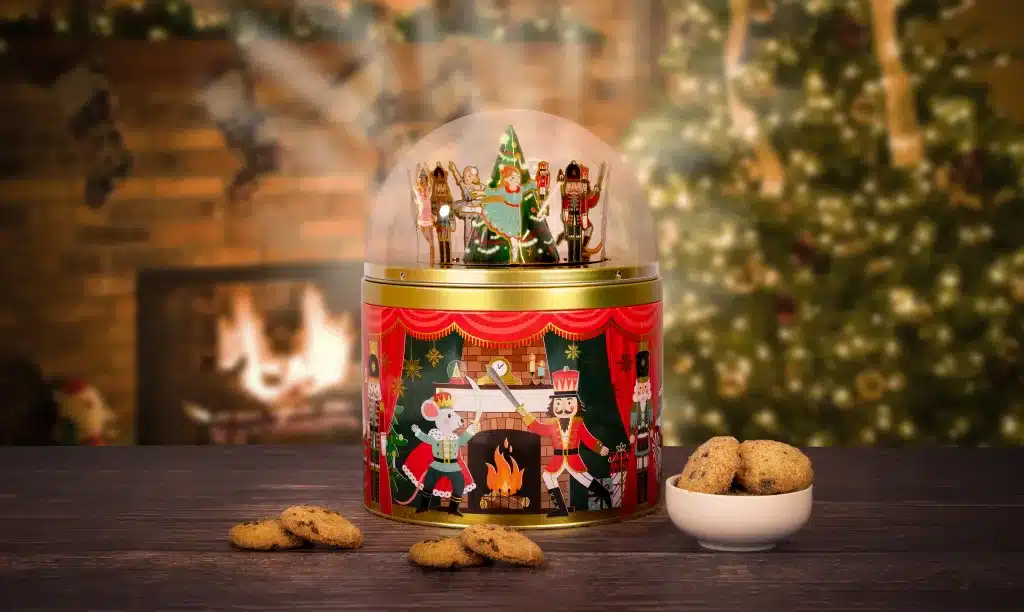
What to Avoid When Creating Seasonal Packaging
Poorly executed seasonal packaging can damage your brand, whilst wasting critical resources and investment. Here are some of the common pitfalls you should avoid:
- Starting too late – Rushed seasonal packaging leads to compromised designs and missed deadlines. Late products miss peak selling periods entirely, which can be catastrophic in date-specific markets where retailers move on immediately after the occasion. Christmas planning that starts in August is already far too late.
- Focusing on the wrong events – With there seemingly being a new occasion or event every other month, it’s important to focus your efforts on the seasons that actually matter to your customers. Not every brand needs Valentine’s Day packaging, and National Biscuit Day won’t drive meaningful sales for most brands. Choose occasions where your products naturally fit and where consumer spending justifies the investment.
- Brand dilution – Going too far with seasonal theming can make your product unrecognisable to loyal customers. If your seasonal packaging looks nothing like your core brand, you risk losing the equity you’ve built. Customers who specifically seek out your products might walk straight past them on the shelf.
- Compromising on quality – Seasonal doesn’t mean disposable. In fact, quite the opposite, as consumers are often seeking products that feel special and worth keeping as collectables. Poor quality materials signal low product value, regardless of what’s inside.
- Overordering stock – Excess seasonal inventory becomes worthless overnight when the occasion passes. Heavy discounting to clear stock hurts margins and can damage luxury brand positioning. Accurate forecasting is key, but conservative estimates often prove wiser than optimistic projections when dealing with date-specific packaging.
- Ignoring cultural differences – Seasonal celebrations vary drastically across regions. What works brilliantly in the UK might confuse consumers elsewhere. If you’re targeting multiple regions, research properly and create market-specific variations of your packaging.
Avoid these common problems, and your seasonal packaging stands a far better chance of success.
Examples Of Seasonal Packaging
Different occasions demand different approaches to seasonal packaging design. Understanding what resonates during each season helps create packaging that connects emotionally with consumers and drives purchase decisions. We have broken down some of the year’s biggest occasions, providing insight into how you can generally approach seasonal packaging for these events.
Christmas
It goes without saying, but Christmas represents one of the biggest opportunities of the year for major retail and food brands. According to consumer data from the Bank of England from the Bank of England, a typical household spends 29% more in December, compared to any other month. This increased spend is something which brands must capitalise on, and it starts by having the right seasonal packaging in place. Here are some key considerations for a Christmas packaging project:
- Colours – Rich reds and greens remain powerful when executed well, but consider deep burgundy, forest green, and metallic golds. Navy blue with silver or gold creates elegant, contemporary Christmas packaging. White and cream designs with subtle metallic accents work brilliantly for luxury positioning.
- Design – Keep a strong focus on craftsmanship and details, rather than overt cartoons or graphics. By this, we mean intricate patterns, subtle embossing, and textured finishes, which can all help to convey a premium market position. The use of winter landscapes, holly, and animal illustrations continues to prove popular with consumers. Nostalgia continues to be a notable theme in Christmas packaging, with brands tapping into warm childhood memories through vintage-inspired designs and illustrations.
Getting Christmas packaging right is all about balancing festive appeal with brand consistency – designs that embrace the season without losing the premium positioning you’ve built.
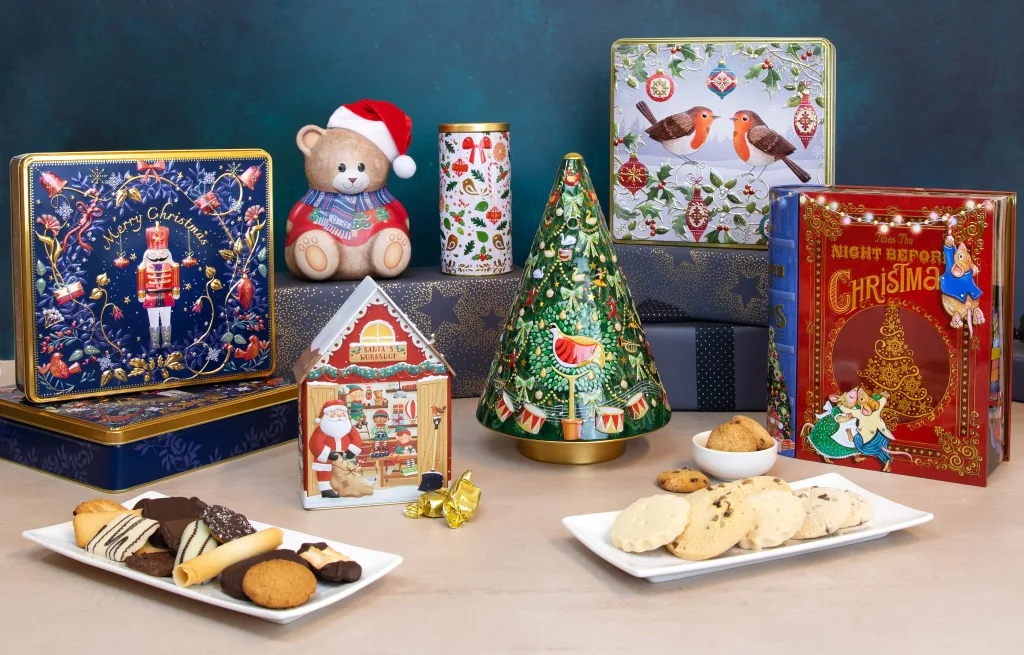
Easter
Easter packaging is all about connecting the themes of renewal, hope and the spring season. It is a growing market as well. Mintel reports that spending on Easter products increased by 8% compared with 2024, up to £1.7 billion. Whilst the Easter season has strong associations with children and family, the chocolate and confectionery market spans all ages, including adult gifting with more luxury-oriented products.
- Colours – Pastels remain a popular choice for Easter. Opt for combinations like sage green with blush pink, or lavender paired with cream. Brighter yellows and greens work well for contemporary designs that feel fresh, and can be perfect for a younger audience.
- Design – Spring flowers and nature-inspired illustrations work well for Easter packaging when kept simple and uncluttered. Designs with clear focal points and plenty of breathing space tend to perform better than busier approaches. Abstract seasonal elements can outperform literal interpretations for premium brands.
The holiday centres on chocolate and confectionery, making packaging design crucial for standing out in a competitive market. With the high-interest spike for these products during Easter, many retailers opt for private-label confectionery solutions to help meet consumer demand. If you need support with a private-label solution for biscuits, chocolate, or confectionery, please contact our team.
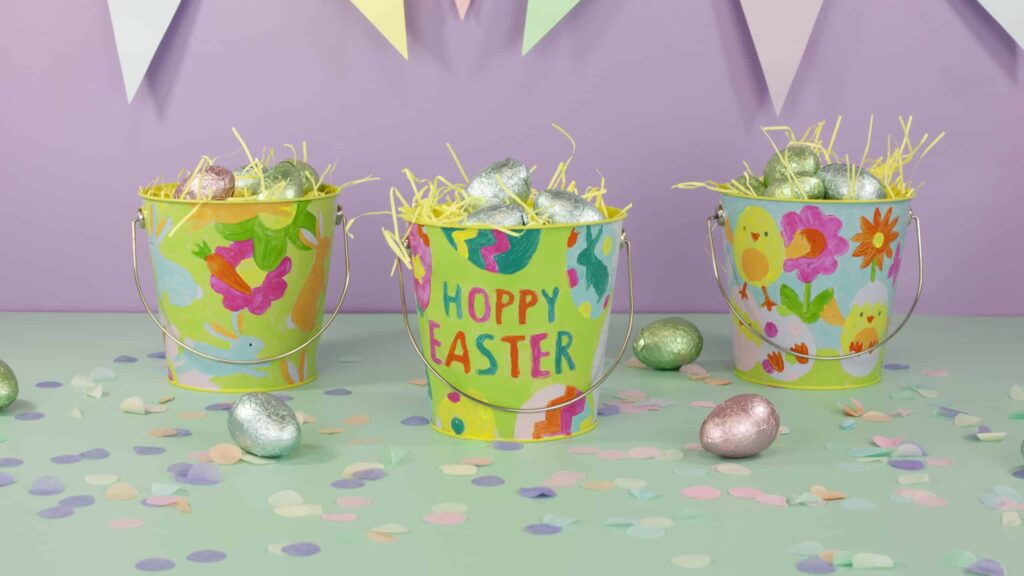
Eid & Ramadan
Eid & Ramadan are important occasions for food brands, particularly in the biscuits, sweets, and confectionery categories. These occasions require packaging that feels generous and celebratory, whilst respecting cultural traditions:
- Colours – Rich jewel tones work perfectly for Eid & Ramadan packaging. Think emerald green, sapphire blue, ruby red, and deep purple paired with gold or silver. These colours embody luxury and celebration whilst respecting the significance of the occasion.
- Design – Geometric patterns inspired by Islamic art create sophisticated, culturally appropriate designs. Crescent moons and stars can work when treated as elegant design elements rather than superficial symbols.
Tin packaging works particularly well for these occasions, creating a premium gift presentation that feels truly special. Find out more about our design and innovation capabilities.
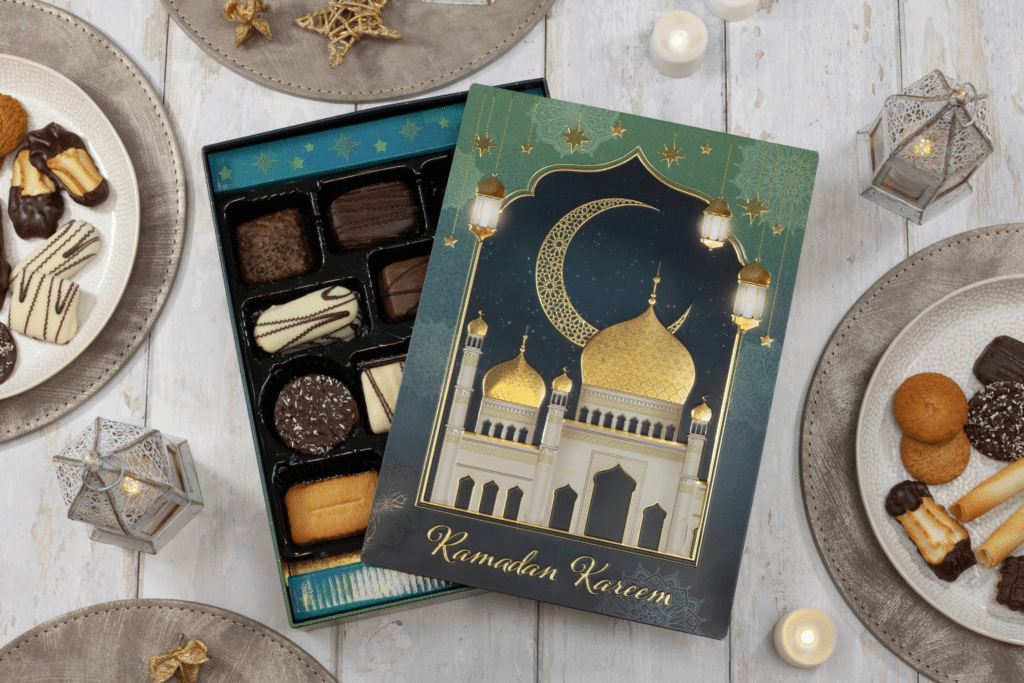
Valentine’s Day
Valentine’s Day packaging works best when it feels romantic without being clichéd. The challenge is creating designs that feel special and gift-worthy whilst avoiding generic heart-covered packaging that can get easily lost in a busy retail environment.
- Colours – Beyond the obvious pinks and reds, you can consider more refined alternatives. Burgundy with gold or rose gold with cream are both great options for Valentine’s Day packaging. Blush pink with navy blue offers a modern, elegant alternative to traditional red.
- Design – Abstract representations of romance can work better than literal hearts or similar depictions. Consider texture and patterns to create elevated packaging that feels like a gift before it’s even opened. Subtle embossing and metallic details create packaging that is worth keeping beyond the day.
Tin packaging is the perfect choice for Valentine’s Day gifting. In particular, chocolates and confectionery become meaningful gifts that feel substantial and thoughtful.
Halloween
Halloween has evolved from being a child’s holiday to a major commercial event for all ages. The best Halloween packaging captures the playful, spooky nature of the occasion, whilst still maintaining quality and shelf appeal.
- Colours – Orange and black continue to dominate during Halloween, and this is a trend that will continue for decades to come. Alongside this, charcoal greys and deep purples have become more prominent in recent years, often contrasted with metallic and orange colours.
- Design – Halloween allows more playfulness than other occasions, but avoid designs that look low-quality or childish unless specifically targeting a younger audience. Silhouettes work better than detailed character illustrations, particularly when angling for a more luxurious audience. Consider shadows, textures, and atmospheric designs rather than cartoon ghosts.
Tin packaging helps Halloween products stand out from mass-market offerings, with tins often being reused for storage or decorations long after the spooky season ends.
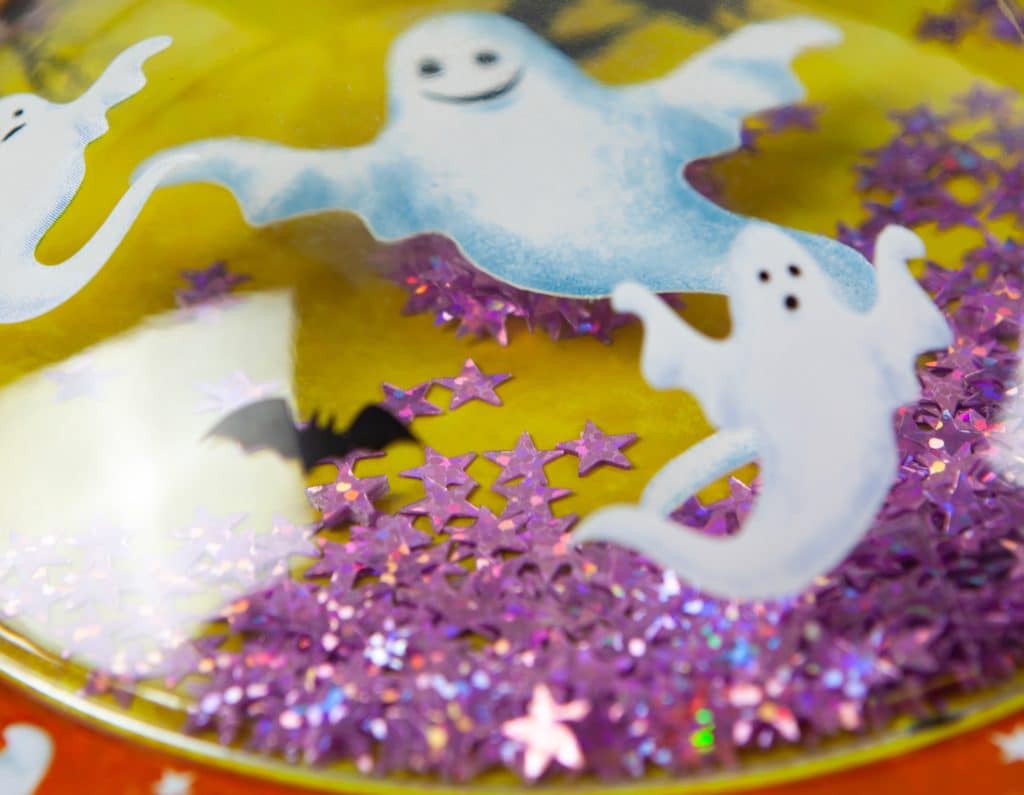
How We Can Help You Create Award-Winning Seasonal Packaging
Silver Crane brings decades of expertise in seasonal packaging design and manufacturing. Our award-winning in-house design studio understands what makes seasonal packaging successful. We combine emotional appeal with proven shelf impact to deliver seasonal packaging that exceeds expectations for you and your customers.
We offer complete end-to-end service, taking your seasonal campaigns from initial concept through to delivered products. Our designers work closely with you to create packaging that captures the essence of each occasion whilst remaining distinctly on-brand. We understand the cultural nuances of different celebrations and create appropriate designs for markets worldwide. Our manufacturing capabilities ensure your seasonal campaigns launch on time, every time.
Contact us to discuss your seasonal packaging requirements.
Contact Us
Say hello
Let us create the solution you need! Get in touch.